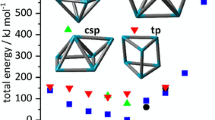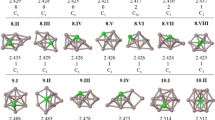Abstract
The interaction of hydrogen with Al n Rh2 + (n = 10–13) clusters is studied by mass spectrometry and infrared multiple photon dissociation (IRMPD) spectroscopy. Comparing the IRMPD spectra with predictions obtained using density functional theory calculations allows for the identification of the hydrogen binding geometry. For n = 10 and 11, a single H2 molecule binds dissociatively, whereas for n = 12 and 13, it adsorbs molecularly. Upon adsorption of a second H2 to Al12Rh2 +, both hydrogen molecules dissociate. Theoretical calculations suggest that the molecular adsorption for n = 12 and 13 is not due to kinetic impediment of the hydrogenation reaction by an activation barrier, but due to a higher binding energy of the molecularly adsorbed hydrogen–cluster complex. Inspection of the highest occupied molecular orbitals shows that the hydrogen molecule initially forms a strongly bound Kubas complex with the Al11–13Rh2 + clusters, whereas it only binds weakly with Al10Rh2 +.





Similar content being viewed by others
References
Dawson VP, Bowles MD (2004) Taming Liquid Hydrogen: The Centaur Upper Stage Rocket, 1958–2002. Diane Publishing Co
Durbin DJ, Malardier-Jugroot C (2013) Review of hydrogen storage techniques for on board vehicle applications. Int J Hydrogen Energy 38:14595–14617. https://doi.org/10.1016/j.ijhydene.2013.07.058
Orimo S-I, Nakamori Y, Eliseo JR et al (2007) Complex hydrides for hydrogen storage. Chem Rev 107:4111–4132. https://doi.org/10.1021/cr0501846
Ley MB, Jepsen LH, Lee Y et al (2014) Complex hydrides for hydrogen storage—new perspectives. Mater Today 17:122–128. https://doi.org/10.1016/j.mattod.2014.02.013
Chaudhuri S, Graetz J, Ignatov A et al (2006) Understanding the role of Ti in reversible hydrogen storage as sodium alanate: a combined experimental and density functional theoretical approach. J Am Chem Soc 128:11404–11415. https://doi.org/10.1021/ja060437s
Baldé CP, Hereijgers BPC, Bitter JH, de Jong KP (2008) Sodium alanate nanoparticles - linking size to hydrogen storage properties. J Am Chem Soc 130:6761–6765. https://doi.org/10.1021/ja710667v
Zaera F (2013) Nanostructured materials for applications in heterogeneous catalysis. Chem Soc Rev 42:2746–2762. https://doi.org/10.1039/C2CS35261C
Jena P (2011) Materials for hydrogen storage: past, present, and future. J Phys Chem Lett 2:206–211. https://doi.org/10.1021/jz1015372
Tyo EC, Vajda S (2015) Catalysis by clusters with precise numbers of atoms. Nat Nanotechnol 10:577–588. https://doi.org/10.1038/nnano.2015.140
Janssens E, Le HT, Lievens P (2015) Adsorption of propene on neutral gold clusters in the gas phase. Chem-A Eur J 21:15256–15262. https://doi.org/10.1002/chem.201500523
Lang SM, Bernhardt TM (2012) Gas phase metal cluster model systems for heterogeneous catalysis. Phys Chem Chem Phys 14:9255–9269. https://doi.org/10.1039/c2cp40660h
Schwarz H (2015) Doping effects in cluster-mediated bond activation. Angew Chem Int Ed 54:10090–10100. https://doi.org/10.1002/anie.201500649
Sanchez A, Abbet S, Heiz U, et al (1999) When Gold Is Not Noble: Nanoscale Gold Catalysts. J Phys Chem A 103:9573–9578. https://doi.org/10.1021/jp9935992
Ferrari P, Molina LM, Kaydashev VE et al (2016) Controlling the adsorption of carbon monoxide on platinum clusters by dopant-induced electronic structure modification. Angew Chem Int Ed 128:11225–11229. https://doi.org/10.1002/anie.201604269
Kiohara VO, Carvalho EFV, Paschoal CWA et al (2013) DFT and CCSD (T) electronic properties and structures of aluminum clusters: Al nx (n = 1–9, x = 0, ± 1). Chem Phys Lett 568–569:42–48. https://doi.org/10.1016/j.cplett.2013.03.005
Upton TH, Cox DM, Kaldor A (1987) Activation and chemisorption of hydrogen on aluminum clusters. In: Jena P, Rao BK, Khanna SN (eds) Physics and chemistry of small clusters. Springer, New York, pp 755–768. https://doi.org/10.1007/978-1-4757-0357-3_100
Pino I, Kroes GJ, Van Hemert MC (2010) Hydrogen dissociation on small aluminum clusters. J Chem Phys 133:184304. https://doi.org/10.1063/1.3502493
Zhang F, Wang Y, Chou MY (2012) Hydrogen interaction with the Al surface promoted by subsurface alloying with transition metals. J Phys Chem C 116:18663–18668. https://doi.org/10.1021/jp306377j
Chopra IS, Chaudhuri S, Veyan JF, Chabal YJ (2011) Turning aluminium into a noble-metal-like catalyst for low-temperature activation of molecular hydrogen. Nat Mater 10:986–986. https://doi.org/10.1038/nmat3174
Menezes WJC, Knickelbein MB (1991) Bimetallic clusters of cobalt and aluminum: ionization potentials versus reactivity, and the importance of geometric structure. Chem Phys Lett 183:357–362. https://doi.org/10.1016/0009-2614(91)90393-N
Nonose S, Sone Y, Onodera K et al (1989) Reactivity study of alloy clusters made of aluminum and some transition metals with hydrogen. Chem Phys Lett 164:427–432. https://doi.org/10.1016/0009-2614(89)85232-7
Vanbuel J, Fernandez EM, Ferrari P et al (2017) Hydrogen chemisorption on singly vanadium-doped aluminum clusters. Chem-A Eur J 23:1–7. https://doi.org/10.1002/chem.201704361
Charkin OP, Mikhailin AA, Klimenko NM (2013) Theoretical modeling of elementary reactions of dissociative addition of an H2 molecule to aluminum clusters MAl12 doped with early 3d and 4d transition metal atoms. Russ J Inorg Chem 58:1479–1488. https://doi.org/10.1134/S0036023613120073
Pramann A, Nakajima A, Kaya K (2001) Photoelectron spectroscopy of bimetallic aluminum cobalt cluster anions: comparison of electronic structure and hydrogen chemisorption rates. J Chem Phys 115:5404–5410. https://doi.org/10.1063/1.1394944
Niu J, Rao BK, Jena P (1992) Binding of hydrogen molecules by a transition-metal ion. Phys Rev B 68:2277–2281. https://doi.org/10.1103/PhysRevLett.68.2277
Kubas GJ (2007) Fundamentals of H2 binding and reactivity on transition metals underlying hydrogenase function and H2 production and storage. Chem Rev 107:4152–4205. https://doi.org/10.1021/cr050197j
Truong NX, Haertelt M, Jaeger BKAA. et al (2016) Characterization of neutral boron-silicon clusters using infrared spectroscopy: the case of Si6B. Int J Mass Spectrom 395:1–6. https://doi.org/10.1016/j.ijms.2015.11.006
Schöllkopf W, Gewinner S, Erlebach W et al (2014) The new IR FEL facility at the Fritz-Haber-Institut in Berlin. In: Proceedings of FEL 2014, Basel, WEB04, pp 629–634
Schöllkopf W, Gewinner S, Junkes H et al (2015) The new IR and THz FEL facility at the Fritz Haber Institute in Berlin. Proc SPIE 9512:95121L. https://doi.org/10.1117/12.2182284
Nesbitt DJ, Field RW (1996) Vibrational energy flow in highly excited molecules: role of intramolecular vibrational redistribution. J Phys Chem 100:12735–12756. https://doi.org/10.1021/jp960698w
Herzberg G (1969) Dissociation energy and ionization potential of molecular hydrogen. Phys Rev Lett 23:1081–1083. https://doi.org/10.1103/PhysRevLett.23.1081
Kawamura H, Kumar V, Sun Q, Kawazoe Y (2001) Magic behavior and bonding nature in hydrogenated aluminum clusters. Mater Chem Phys 115:612–617. https://doi.org/10.1016/j.matchemphys.2009.01.025
Wang H, Wang Y, Lv J et al (2016) CALYPSO structure prediction method and its wide application. Comput Mater Sci 112:406–415. https://doi.org/10.1016/j.commatsci.2015.09.037
Perdew JP, Burke K, Ernzerhof M (1996) Generalized gradient approximation made simple. Phys Rev Lett 77:3865–3868. https://doi.org/10.1103/PhysRevLett.77.3865
Petrie S, Stranger R (2004) DFT and metal–metal bonding: a dys-functional treatment for multiply charged complexes? Inorg Chem 43:2597–2610. https://doi.org/10.1021/ic034525e
Liu Y, Zhang J, Li J et al (2016) Hydrogen, oxygen and nitrogen adsorption on Rh n–1X (n = 2–5, X = 3d, 4d atoms) clusters: a DFT study. Comput Theor Chem 1085:56–65. https://doi.org/10.1016/j.comptc.2016.04.008
Grimme S, Ehrlich S, Goerigk L (2011) Effect of the damping function in dispersion corrected density functional theory. J Comput Chem 32:1456–1465. https://doi.org/10.1002/jcc
Igel-Mann G, Stoll H, Preuss H (1988) Pseudopotentials for main group elements (IIIa through VIIa). Mol Phys 65:1321–1328. https://doi.org/10.1080/00268978800101811
Schäfer A, Huber C, Ahlrichs R et al (1994) Fully optimized contracted Gaussian basis sets of triple zeta valence quality for atoms Li to Kr fully optimized contracted Gaussian basis sets of triple zeta valence quality for atoms Li to Kr. J Chem Phys 100:5829/7. https://doi.org/10.1063/1.467146
Shayeghi A, Johnston RL, Rayner DM et al (2015) The nature of bonding between argon and mixed gold–silver trimers. Angew Chem 54:10675–10680. https://doi.org/10.1002/anie.201503845
Gehrke R, Gruene P, Fielicke A et al (2013) Nature of Ar bonding to small Con + clusters and its effect on the structure determination by far-infrared absorption spectroscopy. J Chem Phys 130:34306. https://doi.org/10.1063/1.3058637
Janssens E, Gruene P, Meijer G et al (2007) Argon physisorption as structural probe for endohedrally doped silicon clusters. Phys Rev Lett 99:1–4. https://doi.org/10.1103/PhysRevLett.99.063401
Lang SM, Claes P, Neukermans S, Janssens E (2011) Cage structure formation of singly doped aluminum cluster cations Al n TM+ (TM = Ti, V, Cr). J Am Soc Mass Spectrom 22:1508–1514. https://doi.org/10.1007/s13361-011-0181-1
Fernández EM, Vega A, Balbás LC (2013) Theoretical study of Al n V+ clusters and their interaction with Ar. J Chem Phys 139:214305. https://doi.org/10.1063/1.4834595
Knickelbein MB (1999) Reactions of transition metal clusters with small molecules. Annu Rev Phys Chem 50:79–115. https://doi.org/10.1146/annurev.physchem.50.1.79
Swart I, Gruene P, Fielicke A et al (2008) Molecular adsorption of H2 on small cationic nickel clusters. Phys Chem Chem Phys 10:5743–5745. https://doi.org/10.1039/b807313a
Swart I, de Groot FMF, Weckhuysen BM et al (2008) H2 adsorption on 3d transition metal clusters: a combined infrared spectroscopy and density functional study. J Phys Chem A 112:1139–1149. https://doi.org/10.1021/jp076702t
Huber K-P (2013) Molecular spectra and molecular structure: IV. Constants of diatomic molecules. Springer, New York. https://doi.org/10.1007/978-1-4757-0961-2
Burkart S, Blessing N, Gantefor G (1999) Indication of a size-dependent transition from molecular to dissociative chemisorption on clusters. Phys Rev B 60:15639–15642. https://doi.org/10.1103/PhysRevB.60.15639
Acknowledgements
This work is supported by the KU Leuven Research Council (GOA/14/007). J.V. would like to thank the FWO—Research Foundation Flanders for a PhD fellowship. P.F. acknowledges CONICyT for a Becas Chile scholarship. A.F. thanks the Deutsche Forschungsgemeinschaft for a Heisenberg grant (FI 893/5).
Author information
Authors and Affiliations
Corresponding author
Electronic supplementary material
Below is the link to the electronic supplementary material.
Rights and permissions
About this article
Cite this article
Vanbuel, J., Jia, My., Ferrari, P. et al. Competitive Molecular and Dissociative Hydrogen Chemisorption on Size Selected Doubly Rhodium Doped Aluminum Clusters. Top Catal 61, 62–70 (2018). https://doi.org/10.1007/s11244-017-0878-x
Published:
Issue Date:
DOI: https://doi.org/10.1007/s11244-017-0878-x




